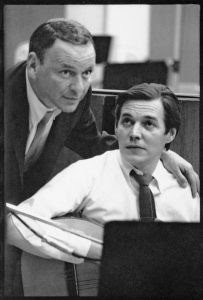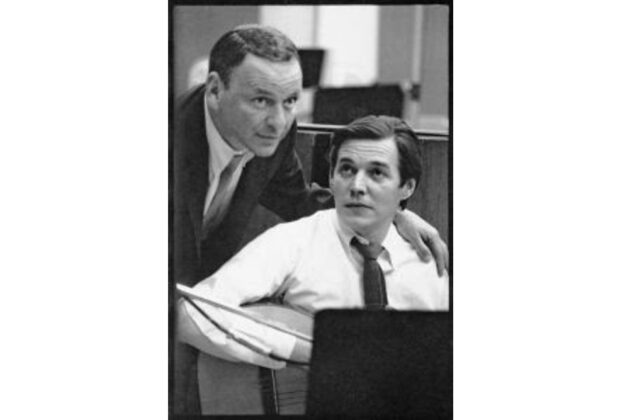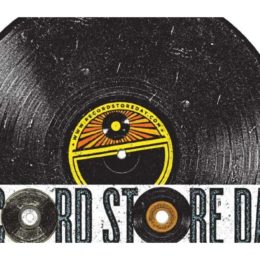Sinatra & Jobim-courtesy Frank Sinatra Enterprises-Photo Ed Thrasher
Frank Sinatra’s acclaimed 1967 album with Brazilian music legend Antonio Carlos Jobim, Francis Albert Sinatra and Antonio Carlos Jobim was reissued in an expanded 50th Anniversary edition during 2017 via Universal Music Enterprises.
I’ve been listening to it lately.
Francis Albert Sinatra & Antonio Carlos Jobim brought together two maestros from divergent musical worlds in a serene sigh of sun-dappled bossa-nova.
In evening studio sessions at Hollywood’s Western Recorders between January 30 and February 1, 1967, Sinatra breathed new life into the album’s 10 songs, accompanied vocally on four by Jobim, who also played guitar on the album.

The album’s tracks include seven Jobim originals and three American Songbook classics, delicately arranged and conducted by Claus Ogerman with a studio orchestra. Ogerman’s studio credits were Wes Montgomery, Kai Winding, and Cal Tjader as a staff arranger for the Verve label on many Creed Taylor productions 1963-1967. He also arranged and conducted the Bill Evans Trio with Symphony Orchestra in 1966.
The 50th Anniversary Edition’s CD and digital configurations implement two bonus tracks: A medley of “Quiet Nights of Quiet Stars”/“Change Partners”/“I Concentrate on You”/“The Girl from Ipanema” from A Man And His Music + Ella + Jobim, and a previously unreleased studio session of “The Girl from Ipanema" from January 31, 1967.
“The 1967 Sinatra/Jobim album is beautiful, all 27 minutes of it, and I’m glad it’s being reissued for a wider audience,” offered KEBF-FM deejay/poet, James Cushing, who hosted the program Jazz Classics in Morro Bay, California.
“The quiet that Jobim’s music contains rubs against Sinatra’s vivid bel-canto extraversion in a memorable way and it’s great to hear the two men singing together, as well. I’m OK with Claus Ogerman’s orchestrations, but honestly, a chamber jazz group of guitar-bass-piano would have done just as well if not better.”
Musician and record producer/deejay David Kessel, the owner of www.cavehollywood.com also provides some unique anecdotes and historical reflections into the relationship his father and step mother had with Sinatra, Jobim and the world of Bossa Nova.
“My dad, jazz guitarist and record producer Barney Kessel had his first recording studio encounter with Frank Sinatra in 1949. He was in the band that cut three tunes in Hollywood on September 15 of that year. This included ‘That Lucky Old Sun,’ ‘Mad About You’ and ‘Stromboli.’
“In the early 1960’s when Sinatra started his Reprise record label, my father was signed to the label. He did three albums, Breakfast at Tiffany’s, Bossa Nova, and Contemporary Latin Rhythms. All three albums had a Bossa Nova/ Cha Cha groove with a surf guitar vibe and cool cheesy organ and horn arrangements. He also released three singles and an EP. A total left field single was ‘Diamonds’ backed with ‘T.V. Commercials.’ Frank and company were well aware of the growing trend of the Latin infusion in pop music and the changing musical culture that was influencing young Americans and hipsters.
“The Latin music trend in America started in the late 50’s and into the 60’s. You don’t normally think about it, but in 1960 Brian Hyland’s ‘Itsy Bitsy Teenie Weenie Yellow Polka Dot Bikini’ smash hit was a Cha Cha. In 1962 ‘Sherry,’ a big hit by the Four Seasons was also a Cha Cha. In 1963 Eydie Gorme had a giant hit ‘Blame It on the Bossa Nova.’ All three songs helped make the Latin trend main stream and a part of our musical fabric. The kicker here is the release of Jobim’s composition ‘Girl from Ipanema’ in 1964 as a single by Astrud Gilberto and Stan Getz. It won a Grammy for best record of the year in 1965. This firmly established the Latin genre as a popular format.
“I met Frank Sinatra in the late 1960’s at Jilly’s in Palm Springs when I was a teenager. He was the consummate gentleman. I was with my dad, stepmom B.J. Baker (both worked with Sinatra on many occasions) and my brother Dan. We sat at a table right next to Frank. He got up and said ‘Barney, Betty, boys, hope you enjoy your meal’ and then came over to us and talked for a few minutes. I was really impressed at what a warm, caring, professional guy he was.”
Harvey Kubernik is the author of 20 books, including 2009’s Canyon Of Dreams: The Magic And The Music Of Laurel Canyon and 2014’s Turn Up The Radio! Rock, Pop and Roll In Los Angeles 1956-1972. Sterling/Barnes and Noble in 2018 published Harvey and Kenneth Kubernik’s The Story Of The Band: From Big Pink To The Last Waltz. In2021 they wrote Jimi Hendrix: Voodoo Child for Sterling/Barnes and Noble. Otherworld Cottage Industries in 2020 published Harvey’s Docs That Rock, Music That Matters.
Kubernik’s writings are in several book anthologies. Including, The Rolling Stone Book Of The Beats and Drinking With Bukowski. Harvey wrote the liner notes to the CD re-releases of Carole King’s Tapestry, The Essential Carole King, Allen Ginsberg’s Kaddish, Elvis Presley The ’68 Comeback Special, The Ramones’ End of the Century and Big Brother & the Holding Company Captured Live at The Monterey International Pop Festival.
During 2006 Harvey spoke at the special hearings initiated by The Library of Congress held in Hollywood, California, discussing archiving practices and audiotape preservation.
In 2017 Harvey Kubernik appeared at the Rock and Roll Hall of Fame in Cleveland, Ohio, as part of their Distinguished Speakers Series.














